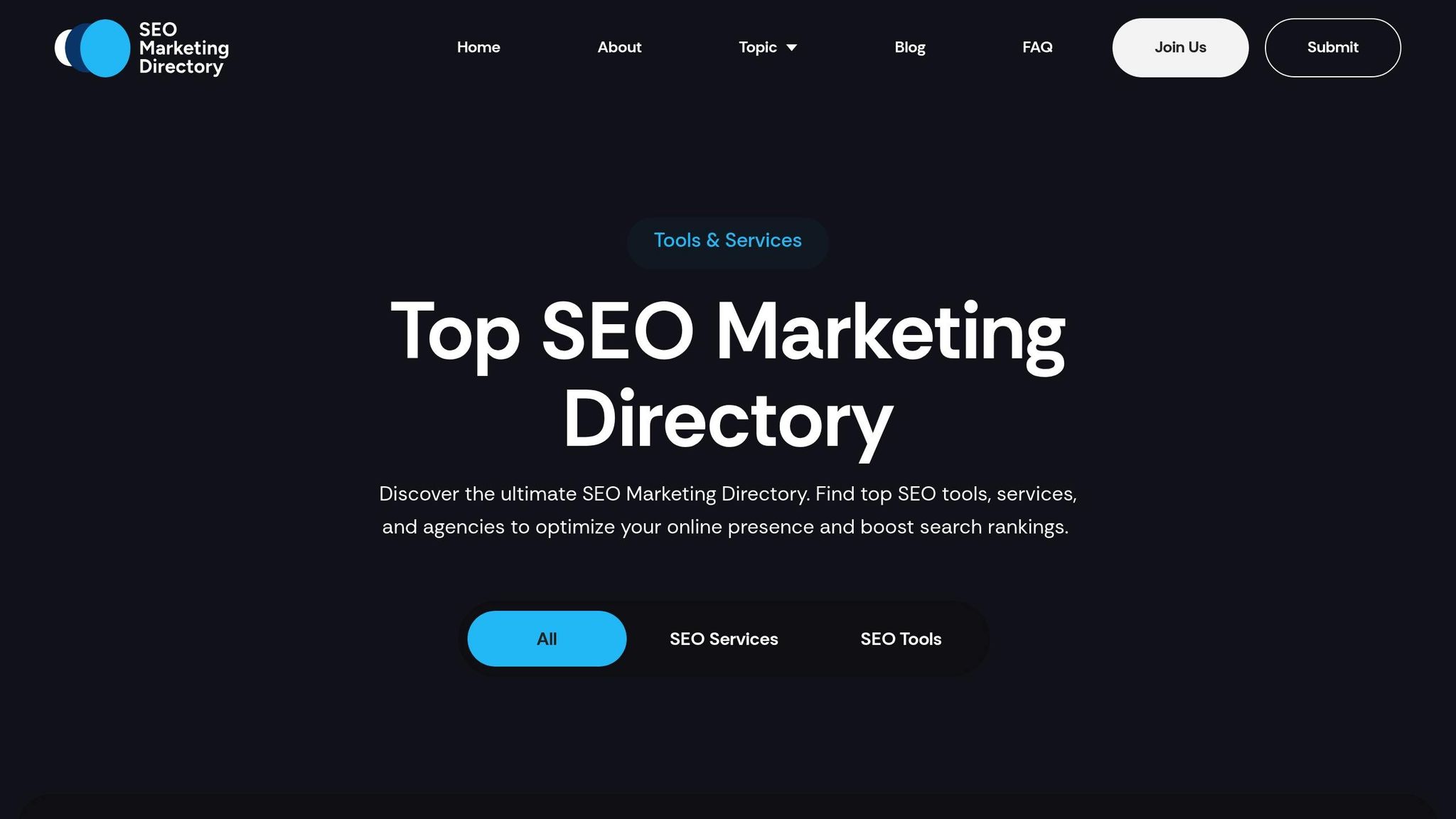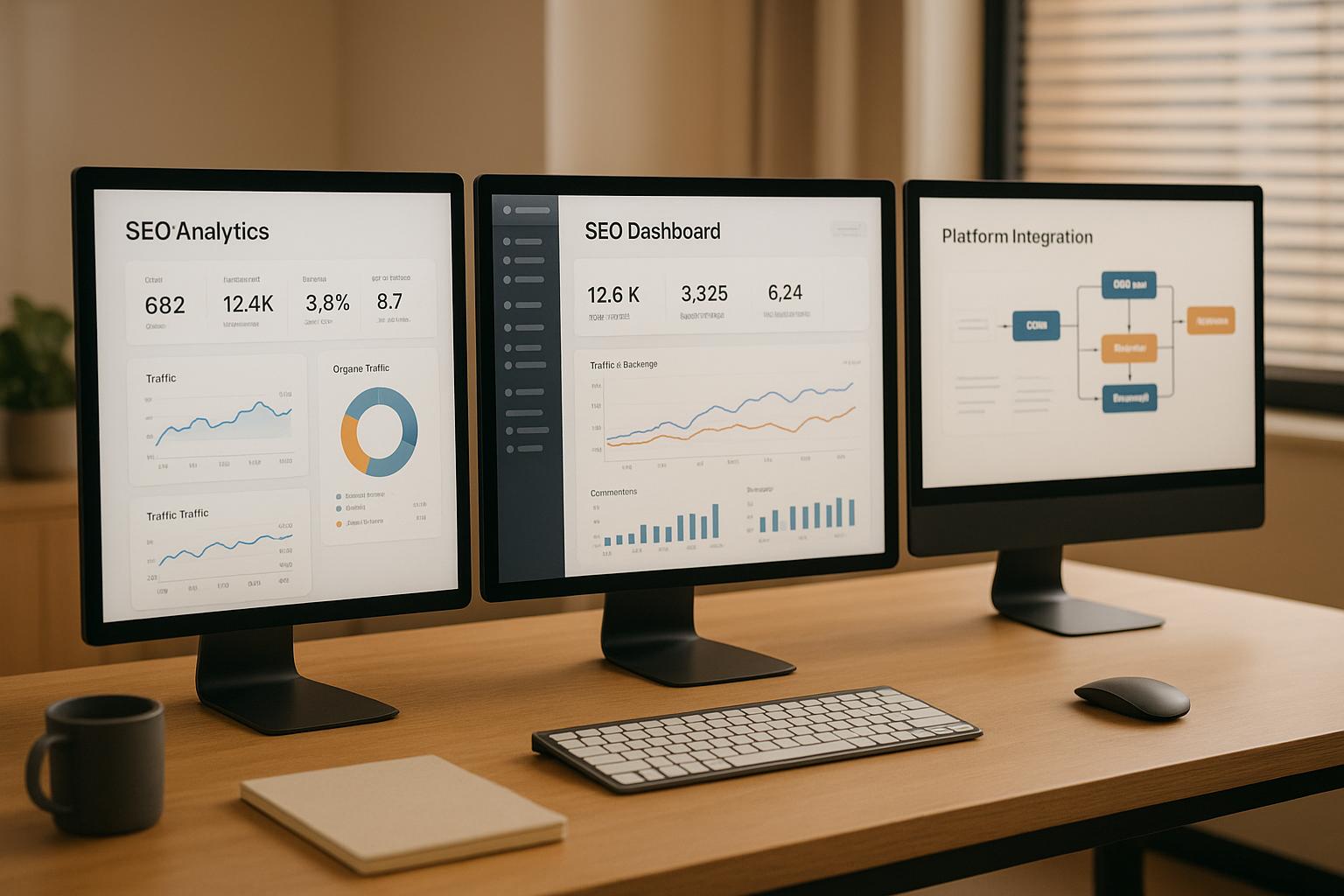In SEO, the choice between AI tools and manual content creation depends on your goals, budget, and content needs. AI tools are fast, cost-effective, and ideal for handling repetitive tasks like keyword research, content drafts, and technical audits. Meanwhile, manual creation delivers personalized, high-quality content that captures a brand’s tone and connects with audiences on a deeper level.
Key Takeaways:
- AI SEO Tools: Great for speed, scalability, and routine tasks. They analyze keywords, optimize content, and handle technical SEO with minimal effort.
- Manual Content Creation: Best for nuanced, detailed work like thought leadership, storytelling, and emotionally engaging content.
- Hybrid Approach: Pair AI for efficiency with human writers for depth and creativity.
Quick Comparison
| Feature | AI SEO Tools | Manual Content Creation |
|---|---|---|
| Speed | Produces content in minutes | Takes hours or days per piece |
| Cost | Lower for high-volume tasks | Higher due to labor costs |
| Scalability | Easily handles large projects | Requires more resources to scale |
| Brand Voice | Requires setup for consistency | Naturally aligns with brand tone |
| SEO Accuracy | Reliable for technical tasks | Relies on expertise for nuanced strategies |
| Emotional Appeal | Limited emotional depth | Strong emotional connection |
For most businesses, combining both approaches ensures efficiency without sacrificing quality.
AI SEO Writing vs Human SEO Expert (the winner was clear)
AI SEO Tools Explained
AI-powered SEO tools are revolutionizing the way businesses approach search engine optimization. By leveraging machine learning and natural language processing, these tools handle tasks that once required hours of manual effort. They’re designed to understand search intent, analyze SERP (Search Engine Results Page) trends, and adjust recommendations as search algorithms evolve. This makes them a game-changer for companies aiming to scale their content strategies while maintaining high standards.
Main Features of AI SEO Tools
Modern AI SEO platforms come packed with features that simplify and accelerate the optimization process:
- Automated Keyword Research: These tools analyze search queries, uncover long-tail keyword opportunities, and suggest keyword clusters that might be missed during manual research.
- Content Creation and Optimization: AI tools can draft SEO-friendly content outlines, recommend meta descriptions, and even generate full drafts based on targeted keywords. They also analyze top-ranking pages to identify patterns that search engines favor, integrating those insights into their suggestions.
- Technical SEO Analysis: AI tools excel at crawling websites to detect issues like duplicate content, broken links, and slow page speeds. They prioritize fixes based on their potential impact on search rankings, making it easier to address critical problems.
- Competitor Analysis: These tools monitor competitors’ content strategies, track keyword rankings, and identify content gaps in your own approach. What used to take weeks of manual analysis can now be done in just a few hours.
- Real-Time Algorithm Updates: As search engines update their algorithms, AI tools adjust their recommendations almost instantly, ensuring your strategy stays aligned with current best practices.
These features not only enhance SEO analysis but also dramatically speed up the process, allowing businesses to focus on strategy rather than execution.
How AI Tools Speed Up SEO Work
The efficiency of AI SEO tools becomes clear when you look at how much time they save. For example, while a human SEO specialist might analyze 50–100 keywords in a day, AI tools can process thousands of keywords simultaneously. They deliver insights on search volume, competition, and ranking difficulty in a fraction of the time.
Content production also gets a major boost. AI tools can create content briefs, suggest headings, and draft initial versions in minutes. This doesn’t replace human creativity but provides a strong starting point for content creators to refine and enhance.
Other time-consuming tasks, like updating meta tags across hundreds of pages or optimizing image alt text, are simplified through automation. Similarly, internal linking structures can be reorganized with ease, freeing up teams to focus on high-level strategy.
Real-time data analysis is another standout benefit. Instead of waiting for weekly or monthly reports, AI tools continuously monitor rankings, traffic, and conversions, sending alerts when significant changes occur. This instant feedback allows for quicker adjustments.
Additionally, these tools reduce the learning curve for new team members. Built-in guidance and suggestions enable newcomers to produce quality SEO work without needing to master every technical detail upfront.
Finding AI SEO Tools with Top SEO Marketing Directory

Given the many features and time-saving benefits of AI SEO tools, finding the right one for your business is essential. The Top SEO Marketing Directory simplifies this process by offering a curated collection of AI-powered SEO platforms.
The directory organizes tools by specific functions, such as keyword research, content optimization, technical SEO, and link building. Each listing includes detailed comparisons of features, pricing, and user reviews, helping you make well-informed decisions.
With filtering options, you can narrow down tools based on your business size, budget, or specific needs. Whether you’re a startup looking for cost-effective solutions or an enterprise seeking advanced features, the directory helps you find the right match.
In addition to tool listings, the site provides expert guidance and insights to help align your SEO strategy with the best available tools. This eliminates much of the trial and error involved in tool selection.
For businesses ready to explore AI-driven SEO solutions, the directory offers three access levels: a free basic plan to browse options, a $49/month premium plan for enhanced access, and custom enterprise solutions tailored for larger organizations. It’s an invaluable resource for anyone looking to elevate their SEO game with AI.
Manual Content Creation Explained
Manual content creation is all about relying on human expertise to drive SEO and content marketing efforts. Unlike AI, which processes information at lightning speed, human writers bring depth and creativity to the table, carefully managing each step of the process. This approach typically involves tools for keyword research, competitor analysis to shape strategies, and meticulous writing infused with human judgment. It’s a hands-on method that stands in stark contrast to the automated efficiencies of AI, which we’ll discuss later.
The process kicks off with SEO specialists conducting keyword research and competitor analysis to craft a solid content strategy. From there, writers take over, creating original content that seamlessly incorporates target keywords while keeping the material engaging and coherent. Rigorous editing and thorough research ensure every piece meets high-quality standards.
Benefits of Human-Written Content
Human writers have the unique ability to maintain a brand’s voice and craft engaging narratives. They understand the subtle nuances of a company’s tone and messaging, ensuring that every piece aligns with the brand’s identity. This kind of consistency helps build trust and fosters long-term recognition with audiences.
Writers also excel at using metaphors, humor, and cultural references to create emotional connections with readers. They adapt quickly to shifting trends and audience preferences, focusing on addressing user needs instead of just stuffing in keywords. With human oversight, content is thoroughly researched, verified, and packed with insights, resulting in work that carries authority and credibility.
Another key advantage is flexibility. Human writers can adapt tone and messaging to suit different platforms and audiences. They can also craft content that serves multiple purposes, ensuring it resonates across various marketing channels.
Drawbacks of Manual Content Creation
Despite its strengths, manual content creation comes with challenges, particularly in today’s fast-paced digital world. One major hurdle is the time and cost involved. Producing content manually can be expensive, especially for smaller businesses, as experienced writers and project management teams often come with a hefty price tag.
Scalability is another issue. As the demand for content grows, hiring and training skilled writers becomes a significant investment. Managing larger teams while maintaining consistent quality adds an extra layer of complexity.
There’s also the potential for inconsistent output. Different writers may have varying styles, and even seasoned professionals might need additional research or expert input for highly technical topics. This can extend timelines and inflate costs.
When Manual Creation Works Best
While AI tools are great for handling routine tasks, manual content creation shines when nuanced, high-stakes content is required. For example, complex technical topics benefit from human writers who can break down intricate ideas into digestible explanations. Content tied closely to brand identity - like mission statements, executive communications, or cornerstone marketing messages - requires the expertise of a skilled writer.
Thought leadership pieces, which rely on original insights and personal experiences, are best crafted by humans. Similarly, crisis communication and sensitive topics demand emotional intelligence and awareness, which only human authors can provide. Long-form investigative pieces, involving deep research and the synthesis of information from multiple sources, also thrive under manual creation.
For businesses with smaller content needs, working with talented freelancers or a compact in-house team can deliver a strong return on investment compared to automated solutions. This approach ensures quality without the overhead of scaling large teams.
sbb-itb-5be333f
AI SEO Tools vs Manual Content Creation: Direct Comparison
When deciding between AI-driven tools and manual content creation, it’s crucial to weigh factors like speed, scalability, quality, cost, and adaptability. Each plays a unique role in shaping your SEO strategy.
Main Comparison Areas
AI tools produce content in minutes, making them perfect for businesses that need a steady stream of output. On the other hand, manual content creation takes more time but delivers storytelling that resonates deeply with your brand and audience.
Scaling is another key difference. AI tools can handle large-scale projects effortlessly, while manual creation often requires expanding your team to meet increased demands.
In terms of quality, AI tools excel at producing technically accurate content. However, human writers bring emotional depth, cultural awareness, and creativity, which can be invaluable for connecting with your audience.
Below is a side-by-side comparison to help you evaluate these factors more clearly.
Feature Comparison Table
| Feature | AI SEO Tools | Manual Content Creation |
|---|---|---|
| Speed | Content is generated within minutes | Requires several hours per article |
| Cost Effectiveness | More affordable for routine tasks | Higher costs due to human labor |
| Scalability | Scales easily without extra resources | Scaling requires more personnel and budget |
| Brand Voice Consistency | Can maintain consistency with proper setup | Naturally excels at capturing authentic brand voice |
| Technical SEO Accuracy | Reliably adheres to SEO standards | Leverages expertise for nuanced SEO strategies |
| Emotional Connection | Often lacks emotional depth | Builds stronger emotional engagement |
| Fact-Checking | Needs thorough verification for accuracy | Relies on subject-matter expertise for reliability |
| Cultural Sensitivity | Requires monitoring for relevance | Naturally aligns with local nuances |
| Revision Speed | Quick and efficient updates | Slower revision process |
Which Method Fits Different Business Goals
To choose the right approach, consider your business goals and resources.
For startups or small businesses with tight budgets, AI tools are a practical choice for routine tasks like product descriptions, FAQ pages, or basic blog posts. This allows human resources to focus on high-impact content, like founder stories or detailed customer case studies.
E-commerce businesses handling thousands of product pages can benefit greatly from AI’s ability to generate consistent, SEO-ready descriptions quickly. However, for category pages or buying guides that require a personal touch, manual creation remains indispensable.
B2B companies, especially those in technical fields, often find a hybrid model works best. AI can handle routine updates and educational posts, while human writers develop in-depth whitepapers, thought leadership articles, and client case studies that demand specialized knowledge.
Enterprise organizations with established teams often integrate AI for tasks like content ideation, drafting, and SEO optimization. Editors then refine the content to ensure it meets quality standards. Meanwhile, local businesses targeting specific communities often lean toward manual creation, as local writers have a better understanding of the community’s culture and needs.
For small-scale needs, manual creation can be more cost-effective, while high-volume demands make AI tools a game-changer in terms of efficiency.
The Top SEO Marketing Directory offers a variety of resources to help you assess AI tools and manual content creation services. These resources can guide you in finding the best solutions tailored to your business goals and budget.
Benefits and Drawbacks
This section breaks down the advantages and challenges of using AI SEO tools versus manual content creation. Understanding these trade-offs can help you craft an SEO strategy that aligns with your business goals.
AI SEO Tools: Benefits and Drawbacks
AI-powered SEO tools have reshaped content creation by offering speed and efficiency, but they also come with some challenges when it comes to quality and originality.
AI tools excel at generating content quickly and at a lower cost. They’re great for handling repetitive tasks, like ensuring proper keyword placement, heading structures, and other SEO best practices. This level of consistency is hard to match manually, especially when scaling up content production.
However, AI tools often struggle with creativity and originality. Their output can feel formulaic, potentially diluting your brand’s unique voice. There’s also the risk of inaccuracies or outdated information, so thorough fact-checking is a must. Additionally, AI may not handle complex topics that require empathy or nuanced understanding, which can be particularly limiting when addressing sensitive or culturally specific issues.
| AI SEO Tools | Benefits | Drawbacks |
|---|---|---|
| Speed | Creates content quickly | May lack depth and nuance |
| Cost | Cost-efficient for repetitive tasks | Requires investment in quality tools |
| Consistency | Applies SEO practices reliably | Can produce generic, predictable content |
| Scalability | Handles large volumes efficiently | Quality might decline with higher output |
| Availability | Works 24/7 without breaks | Misses the creative intuition of human writers |
Manual Content Creation: Benefits and Drawbacks
Manual content creation focuses on the human element, offering personalized insights and a unique voice that automated tools often can’t replicate.
Human writers bring a distinct advantage when it comes to storytelling, emotional connection, and conveying your brand’s personality. They can craft content that resonates deeply with your audience, helping to build trust and loyalty. Their expertise also allows for in-depth analysis and thought leadership, which is invaluable for tackling complex or niche topics.
However, manual content creation requires a significant investment of time and resources. High-quality content isn’t just written - it’s also carefully edited and refined, which can slow down production. Plus, variations in individual writing styles can sometimes lead to inconsistencies in tone and SEO optimization across different pieces.
| Manual Content Creation | Benefits | Drawbacks |
|---|---|---|
| Quality | Delivers detailed, thoughtful content | Time-intensive and resource-heavy |
| Brand Voice | Communicates authentic messaging | Takes effort to maintain consistency |
| Creativity | Offers fresh, original ideas | Relies on individual writer’s strengths |
| Expertise | Provides deep industry knowledge | Limited by the writer’s specific experience |
| Flexibility | Adapts to changing needs and feedback | Slower turnaround compared to AI tools |
To find the right balance for your business, explore resources like the Top SEO Marketing Directory. It offers guidance on evaluating both AI tools and professional content creation services, helping you choose the best fit for your goals and budget.
Final Recommendations
Deciding between AI SEO tools and manual content creation isn’t about picking sides - it’s about finding the right fit for your business needs.
Main Points to Keep in Mind
AI SEO tools excel in speed and scalability. If you need to produce content quickly and in large volumes while maintaining consistent SEO performance, AI tools are a solid choice. They’re cost-effective for tasks like generating product descriptions or basic blog posts. However, they fall short when it comes to building genuine brand connections or addressing complex, nuanced topics.
Manual content creation prioritizes quality and depth. Human writers bring creativity, emotional understanding, and specialized expertise that AI simply can’t match. Whether it’s crafting compelling brand stories or creating thought leadership content, human input is essential for content that connects on a deeper level. The trade-off? It’s slower and often more expensive.
The best strategies combine both approaches. AI tools are perfect for foundational content - think FAQs, product descriptions, or routine blog posts. Meanwhile, human writers should focus on high-value projects like case studies, thought leadership articles, or emotionally resonant brand storytelling.
This balanced approach ensures your content strategy is both efficient and impactful, aligning with your business objectives.
Choosing the Right Approach for Your Business
Your content strategy should reflect your business’s scale, complexity, and industry demands.
- Startups and small businesses can rely on AI for routine SEO tasks while reserving human effort for crafting key brand messages and unique content that highlights their identity.
- Mid-sized companies often find a hybrid approach effective. AI can handle high-volume needs like weekly blogs or social media updates, while professional writers take on strategic projects like case studies or sales-driven content.
- Large enterprises should use AI to scale content production across multiple product lines or regions. At the same time, they should maintain dedicated teams of writers for high-stakes content that demands precision and creativity.
Industry complexity also plays a role. Fields like healthcare, financial services, or software development often require human expertise to ensure accuracy and compliance. On the other hand, industries that thrive on creativity, like fashion or entertainment, benefit greatly from human writers who can infuse personality and emotion into the content.
For detailed comparisons of top SEO tools and how they can fit into your strategy, check out Top SEO Marketing Directory to maximize your content marketing ROI.
FAQs
How can businesses combine AI SEO tools with manual content creation to improve their SEO strategy?
To effectively merge AI-powered SEO tools with manual content creation, businesses should begin by establishing clear SEO objectives and evaluating their existing strategies. AI tools excel at tasks like keyword research, content optimization, and technical SEO, saving time on routine processes. But here’s the catch: human involvement is essential to ensure the content stays engaging, accurate, and true to your brand's voice.
Keep an eye on performance metrics, use analytics to update your content, and adjust your strategy as needed. By combining the efficiency of AI tools with the creativity and perspective of human input, businesses can craft a more adaptable and impactful SEO approach.
What should small businesses consider when choosing between AI SEO tools and manual content creation?
Small businesses face the challenge of juggling efficiency and genuine connection when choosing between AI SEO tools and manual content creation. AI tools are a time-saver, helping businesses cut costs and produce content quickly - perfect for industries that demand speed or for companies with tight budgets. But there’s a catch: AI-generated content often misses the mark when it comes to originality and that personal touch audiences crave.
On the flip side, manual content creation shines in its ability to deliver tailored, engaging material that truly speaks to specific audiences. Yes, it takes more time and resources, but it gives businesses full creative control and a chance to build deeper connections with their readers. Ultimately, the right choice depends on your business goals, available resources, and what resonates most with your audience. In some cases, blending both approaches might strike the perfect balance.
When is manual content creation better than using AI SEO tools, especially for industries with complex or sensitive topics?
When it comes to industries that handle complex or sensitive subjects, manual content creation often stands out as the better option. Why? Because it offers a level of precision, customization, and adherence to strict standards that automated tools can't always achieve. Human creators have the ability to craft content that addresses subtle nuances, remains true to a brand's voice, and aligns with legal or ethical guidelines.
This is especially true in areas like healthcare, finance, or law, where accuracy and sensitivity aren't just important - they're non-negotiable. While AI tools can help streamline certain tasks, they often fall short when it comes to fully grasping context or meeting the detailed requirements these industries demand.


